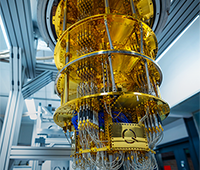
The Blue Waters petascale computing facility at the National Center for Supercomputing Applications, located at the University of Illinois at Urbana-Champaign campus. (Photo: Courtesy of HorsePunchKid via Wikimedia Commons)
Epilepsy is the fourth most common human neurological disorder in the world—a disorder characterized by recurrent, unprovoked seizures. According to the Centers for Disease Control, a record number of people in the United States have epilepsy: 3.4 million total, including nearly half a million children. At this time, there’s no known cause or cure, but with the help of NCSA’s Blue Waters supercomputer at the University of Illinois at Urbana-Champaign, researchers like Ivan Soltesz are making progress.
The Soltesz lab at Stanford University is using Blue Waters to create realistic models of the hippocampus in rat brains. The hippocampus is a seahorse-shaped structure located in the temporal lobe of the brain, and is responsible for forming short-term memories. The hippocampus is thought to be the site of origin of temporal lobe epilepsy, which is the most common variant of the disease.
Generally, areas of the brain process information independently but periodically synchronize their activity when information is transferred across brain regions, for instance as part of the formation of new memories. However, in the epileptic brain, this process of synchronization can result in seizures.
“There is a theory that the healthy hippocampus generates very strong oscillations in the electric field during movement. In epilepsy it is thought that something goes wrong in the mechanisms that generate these oscillations. Instead of normal oscillations, seizures are generated,” says Ivan Raikov, who is part of the Soltesz lab.
The team’s computational research aims to replicate the results of past behavioral research. In those experiments, researchers had rats run on treadmills for several minutes until cells in the hippocampus recognized locations. Often the rats had to run repeatedly to learn their environment.
With the computational modeling on Blue Waters, the Soltesz team began simulating ten-second real time long experiments in order to model those same rat on a treadmill processes. However, even 10-second simulations can take an incredible amount of computer processing power to complete. Using 2,000 nodes (64,000 core equivalents) on Blue Waters, these simulations still take 14 hours of compute time. If this were done on a new, high end laptop it would take almost 26 years to simulate one 10-second experiment.
“Running long, realistic simulations would be impossible to do on other systems,” Raikov says. “It is the computational capacity of Blue Waters that makes it possible to have at least several tens of seconds of physical time represented.”
The team is optimistic that these simulations will help them acquire needed basic knowledge—the role of the hippocampus and how information is transmitted. Understanding how this region of the brain works will potentially allow them to relate the structural differences between a typical brain and one affected by epilepsy.
“We’re hoping once we understand the basic principles of how oscillations are generated in the hippocampus, we can incorporate epileptic changes in our models and how that changes the oscillations,” Raikov says. “If we model the damage that is caused by epilepsy, can we have a simulation that generates seizures or seizure-like behavior? In that way we hope to see some connection between the changes that occur in the brain during the seizure and other pathological events.”
In addition to uncovering the relationship between the hippocampus and pathology, they are also looking to answer what they consider a very fundamental question: How is spatial information represented in the hippocampus and does the oscillatory process have anything to do with it?
“These are very big questions in hippocampal neuroscience, and we believe that understanding those will give us a way to understand episodic memory specifically,” Raikov says.
For other epilepsy related research using Blue Waters, see Curtis Johnson’s work in the Blue Waters Annual Report and on the Blue Waters site.



